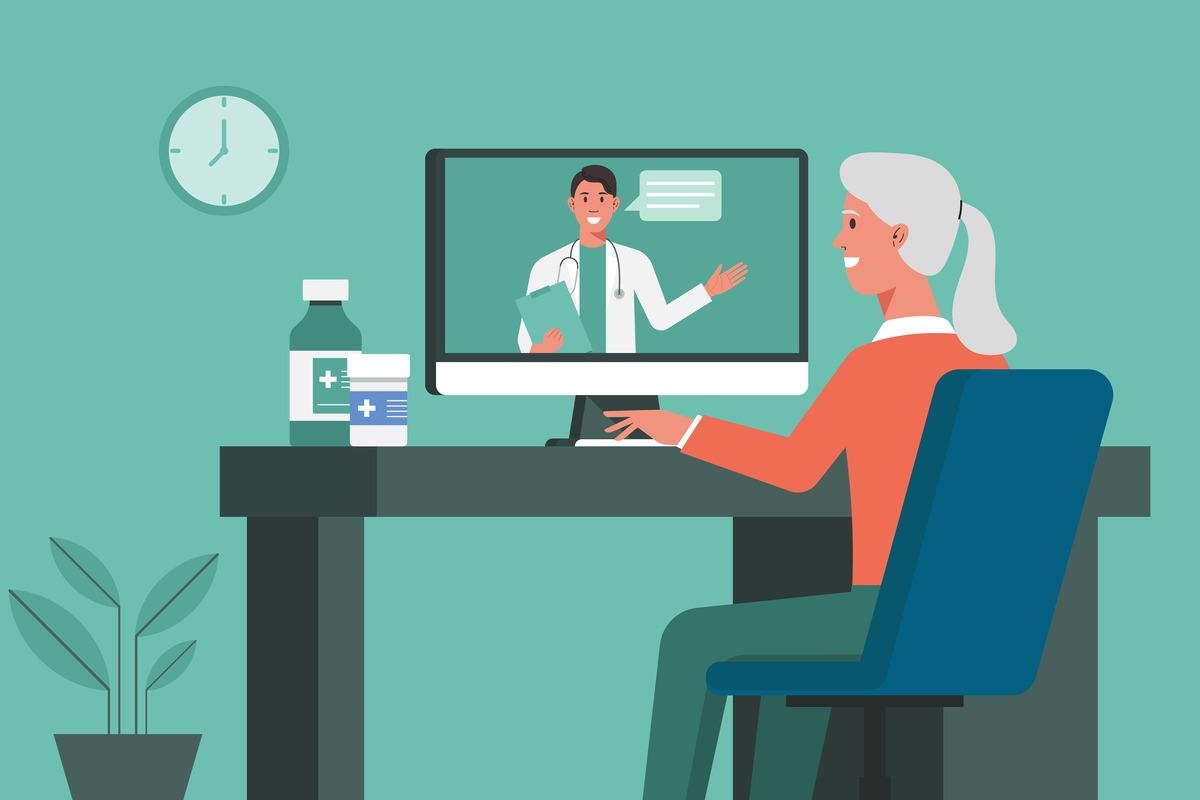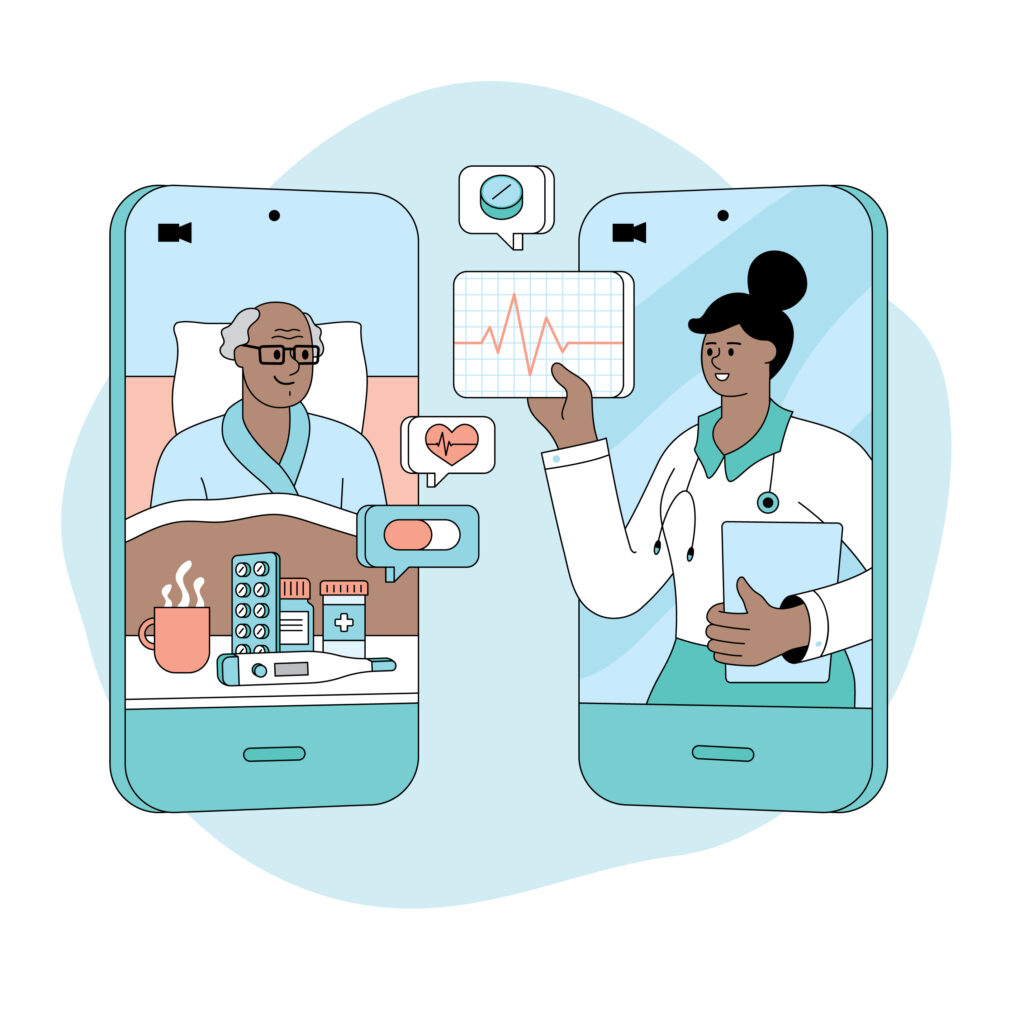Telehealth uses digital technology to provide healthcare remotely. It offers medical services through video calls, apps, and online portals.
Telehealth has revolutionized the healthcare industry by offering convenient, accessible care. Patients can consult doctors without leaving their homes, saving time and reducing travel. This technology bridges the gap for those in remote areas, ensuring they receive timely medical attention.
Telehealth also enhances the efficiency of healthcare providers, allowing them to manage more patients effectively. The rise of telehealth has been accelerated by advances in technology and the increasing demand for flexible healthcare solutions. As a result, it has become an essential component of modern medical practice, improving patient outcomes and overall satisfaction.
Telehealth Evolution
Telehealth has transformed the way we access healthcare. It combines technology with healthcare services. Let’s explore its evolution.
Historical Context
Telehealth is not new. It began in the early 20th century. Doctors used radios to communicate with patients on ships. By the 1960s, NASA used telehealth for astronauts.
In the 1990s, the internet changed telehealth. Online consultations became possible. The reach of healthcare expanded significantly.
Recent Advances
Today, telehealth uses advanced technologies. Video calls and mobile apps are now common. Patients can consult doctors from home.
Artificial Intelligence (AI) plays a big role now. AI helps in diagnosing diseases. It also assists in personalized treatment plans.
| Year | Advancement |
|---|---|
| 2000s | Introduction of broadband internet |
| 2010s | Smartphones and health apps |
| 2020s | AI and machine learning in telehealth |
Telehealth’s future looks promising. It will continue to evolve with new technologies. This will make healthcare more accessible for everyone.

Credit: telehealth.hhs.gov
Key Technologies
Telehealth is changing how we access healthcare. Key technologies are making this possible. Let’s explore some essential tools driving telehealth today.
Video Conferencing
Video conferencing is a vital part of telehealth. It allows patients and doctors to connect face-to-face. Video calls make it easy to discuss health issues. They save time and reduce the need for travel.
Popular video conferencing tools include:
- Zoom
- Skype
- Doxy.me
These platforms offer secure, high-quality video calls. They ensure privacy and comply with health regulations.
Remote Monitoring
Remote monitoring helps track patients’ health from home. Devices like wearables and sensors collect data. Doctors can see this data in real-time. It helps manage chronic diseases and monitor recovery.
Key remote monitoring tools include:
| Device | Function |
|---|---|
| Smartwatches | Track heart rate and activity |
| Blood Pressure Monitors | Measure blood pressure |
| Glucose Monitors | Check blood sugar levels |
These devices send data to healthcare providers. It helps them make informed decisions quickly.
Benefits For Patients
Telehealth offers numerous benefits for patients. It improves healthcare delivery and makes it easier for people to get the care they need. Here are some key advantages:
Convenience
Telehealth provides unmatched convenience for patients. You can attend appointments from your home. This eliminates the need for travel. You save time and money on transport.
Imagine not having to take a day off work. You can schedule appointments during your lunch break. This flexibility helps you manage your health better.
For parents, telehealth is a blessing. You can consult a doctor without arranging childcare. This makes life much easier for busy families.
Access To Specialists
Telehealth gives you better access to specialists. You can consult top doctors without leaving your town. This is especially helpful for people in rural areas.
Specialists are often located in big cities. With telehealth, distance is no longer a barrier. You can get expert advice from the comfort of your home.
Telehealth also reduces wait times. You get quicker appointments with specialists. This leads to faster diagnosis and treatment.
| Benefit | Details |
|---|---|
| Convenience | Attend appointments from home, save time and money |
| Access to Specialists | Consult top doctors without travel, reduced wait times |
Telehealth is transforming healthcare for the better. It makes life easier and healthier for everyone involved.
Challenges And Barriers
Telehealth has transformed healthcare, offering convenience and accessibility. However, several challenges and barriers need addressing. These barriers can affect the effectiveness and reach of telehealth services. Let’s explore some key issues.
Technical Issues
Technical problems are a major barrier to telehealth. Many patients experience poor internet connections. A weak connection can disrupt video calls, causing delays. Some patients lack the necessary devices. Smartphones and computers are essential for telehealth, but not everyone has them.
Here are some common technical issues:
- Internet connectivity problems
- Lack of necessary devices
- Software compatibility issues
Healthcare providers also face challenges. They need reliable software for telehealth. Sometimes, the software crashes or has bugs. This can disrupt patient care and cause frustration.
Regulatory Hurdles
Regulatory barriers are another challenge. Different regions have different laws for telehealth. These laws can be complex and confusing. Some areas do not allow telehealth across state lines. This limits the reach of telehealth services.
Here are some key regulatory issues:
| Issue | Description |
|---|---|
| Licensing | Providers need licenses for each state they serve. |
| Reimbursement | Insurance companies may not cover telehealth. |
| Privacy | Strict laws protect patient data, complicating telehealth. |
Understanding and navigating these regulations is crucial. Providers must stay updated on the latest laws. This ensures compliance and smooth operation of telehealth services.
Impact On Healthcare Providers
Telehealth has brought significant changes to healthcare providers. These changes affect their workflows, training needs, and overall efficiency. Understanding these impacts is crucial for a smooth transition to telehealth services.
Workflow Changes
Implementing telehealth requires adjustments in daily workflows. Providers must manage both in-person and virtual appointments. This dual approach can streamline operations but needs careful planning.
Scheduling becomes more flexible with telehealth. Patients can book appointments without geographical constraints. This flexibility increases appointment availability and helps reduce missed appointments.
Documentation processes also change. Digital records must be updated in real-time. This ensures accurate and timely patient information.
Training Needs
Healthcare providers need proper training to use telehealth platforms. Training ensures they can navigate digital tools efficiently.
Technical Skills are essential for providers. They must learn to use video conferencing software and electronic health records (EHR) systems.
Communication Skills are equally important. Providers must effectively communicate with patients through screens. This requires adapting their usual bedside manners to a virtual setting.
Continuous Education is vital. Telehealth technology evolves rapidly. Providers must stay updated with the latest features and best practices.
| Aspect | Impact |
|---|---|
| Scheduling | More flexible, reduces missed appointments |
| Documentation | Real-time updates, accurate patient info |
| Technical Skills | Necessary for using telehealth tools |
| Communication Skills | Adapting to virtual interactions |
| Continuous Education | Staying updated with new technology |
Telehealth In Rural Areas
Telehealth offers a lifeline to rural areas. It provides healthcare access where facilities are scarce. Rural communities benefit immensely from these digital health services.
Bridging Gaps
Telehealth bridges the gap between patients and doctors. People in remote areas often travel long distances for medical care. With telehealth, they can consult doctors from home.
Many rural areas lack specialist doctors. Telehealth connects patients to specialists without the need for travel. This saves time and money for rural residents.
Telehealth reduces the burden on local clinics. It allows doctors to focus on urgent cases. This improves overall healthcare quality in rural areas.
Community Health
Telehealth plays a vital role in community health. It provides continuous care to chronic patients. Regular follow-ups are easier with telehealth services.
Telehealth supports mental health care. It offers counseling and therapy sessions online. This is crucial for areas with limited mental health services.
Preventive healthcare is enhanced through telehealth. Regular screenings and health education reduce disease spread. Communities stay healthier with these proactive measures.
| Benefits of Telehealth | Impact on Rural Areas |
|---|---|
| Access to Specialists | Improved Specialist Care |
| Reduced Travel | Cost and Time Savings |
| Continuous Care | Better Chronic Disease Management |
| Mental Health Support | Enhanced Mental Well-being |
| Preventive Health | Healthier Communities |
Future Trends
Telehealth continues to evolve rapidly. Exciting trends shape its future. Two key trends stand out: AI Integration and Wearable Devices.
Ai Integration
Artificial Intelligence (AI) plays a big role in telehealth. AI helps doctors with accurate diagnoses. AI-powered chatbots answer patient queries quickly.
AI also assists in predicting patient outcomes. It analyzes vast amounts of data in seconds. This helps in personalizing patient care.
| AI Application | Benefit |
|---|---|
| Chatbots | Quick answers for patients |
| Data Analysis | Personalized care plans |
| Diagnosis Assistance | Accurate and timely diagnoses |
Wearable Devices
Wearable devices are transforming telehealth. Devices like smartwatches monitor health in real-time. They track heart rate, steps, and sleep patterns.
Wearables send data to healthcare providers instantly. This helps in early detection of health issues. It allows timely intervention, improving patient outcomes.
- Smartwatches
- Fitness trackers
- Health monitoring patches
Wearables also encourage patients to stay active. They provide reminders and motivational feedback. This promotes healthier lifestyles and better health management.

Credit: www.news-medical.net
Policy And Regulation
Telehealth is transforming healthcare delivery. Policies and regulations shape its growth. Governments and organizations set rules. These rules ensure safety and effectiveness.
Current Policies
Current policies support telehealth expansion. They address patient privacy and data security. HIPAA regulations are key in the U.S. They protect patient information. Licensing is also important. Providers must be licensed in the patient’s state. Some regions have interstate agreements.
Future Considerations
Future policies will evolve with technology. Artificial Intelligence and machine learning will play roles. Regulations must adapt to new tools. Payment models need changes too. Insurance coverage for telehealth is growing. Policymakers must ensure equitable access.
| Aspect | Current Policy | Future Considerations |
|---|---|---|
| Privacy | HIPAA regulations | Enhanced data security |
| Licensing | State-specific licenses | Interstate agreements |
| Payment | Limited insurance coverage | Broader insurance coverage |

Credit: telehealth.hhs.gov
Frequently Asked Questions
What Does Telehealth Mean?
Telehealth means using digital communication technologies to provide healthcare services remotely. This includes video calls, phone consultations, and online messaging.
What Do You Use Telehealth For?
Telehealth is used for virtual doctor visits, mental health therapy, prescription refills, and managing chronic conditions. It offers convenience and accessibility.
What Is An Example Of Telehealth?
An example of telehealth is a virtual doctor’s appointment. Patients consult with healthcare providers via video calls, saving time.
Is Telehealth Dehumanizing?
Telehealth is not dehumanizing. It offers convenient, efficient care while maintaining patient-doctor communication. Personal interaction and empathy remain crucial.
Conclusion
Telehealth is revolutionizing healthcare by offering convenient, accessible services. It bridges gaps, especially for remote areas. Embracing telehealth can lead to better health outcomes and efficiency. As technology advances, telehealth will continue to grow, ensuring quality care for all. Explore telehealth options and experience the future of healthcare today.

